Bell UH-1N Twin Huey
| UH-1N Iroquois CH-135 Twin Huey | |
|---|---|

| |
| A UH-1N "Huey" from squadronVMM-261, (Reinforced),2012 | |
| Role | Utility helicopter |
| National origin | United States / Canada |
| Manufacturer | Bell Helicopter |
| First flight | April 1969 |
| Introduction | October 1970 |
| Status | In service |
| Primary users | United States Air Force United States Marine Corps(historical) Canadian Forces(historical) United States Navy(historical) |
| Produced | 1969–1970s |
| Developed from | Bell UH-1H Iroquois |
| Variants | Bell 212 Bell 412 Bell UH-1Y Venom |
TheBell UH-1N Twin Hueyis a mediummilitary helicopterdesigned and produced by the American aerospace manufacturerBell Helicopter.It is a member of the extensiveHuey family,the initial version was theCUH-1N Twin Huey(laterCH-135 Twin Huey), which was first ordered by theCanadian Forcesin 1968.
Barely a year following initial discussions, the UH-1N performed itsmaiden flightin April 1969. Its procurement by the US military was initially controversial due to the high level of Canadian content, such as itsPratt & Whitney Canada PT6Tturboshaftengines. However, the acquisition was approved and the Twin Huey was quickly delivered to theUnited States Air Forceand being sent to front line combat units inVietnamin October 1970. The following year, the Canadian Forces,United States Marine Corps,and theUnited States Navyall received their first examples; Bell was also quick to adapt the Twin Huey into a civilian helicopter, theBell 212,as well as the laterBell 412.[1]
The Twin Huey would see service in numerous conflicts, the first being theVietnam War,where they were commonly used to supportSpecial Forcesreconnaissance missions. On the home front, they were used as the main utility helicopter at variousICBMlaunch sites, as well as operating as executive transports for carrying the US president and other high-ranking officials byMarine Helicopter Squadron One.USMC UH-1Ns were active during the2003 invasion of Iraq,providing reconnaissance, communications, andclose air supportto ground forces. Overseas, UH-1Ns participated in theColombian armed conflictand theFalklands War.In the 2010s and 2020s, multiple operators were in the process of replacing the Twin Huey with newer helicopters, such as theBell UH-1Y Venom(a development of the UH-1N) and theAgustaWestland AW139.
Development
[edit]The UH-1N was originally developed out of negotiations between theCanadian Forces(CF) andBell Helicopteron the topic of a new utility helicopter during 1968.[2]Specifically, the CF wanted it to be based on the stretched-fuselageBell 205,which the service already had experience of, but instead powered by a pair of engines for a higher level of safety. Furthermore, the selection of this engine, thePratt & Whitney Canada PT6Tturboshaftengine, was reportedly due to political factors. Its initial designation wasCUH-1N Twin Huey;later, the CF adopted a new designation system under which the rotorcraft was redesignatedCH-135 Twin Huey.[2][3]The CF approved the development of the rotorcraft on 1 May 1968,[1]a total of 50 CH-135s were procured, the deliveries of which commenced during May 1971.[4]


The US military quickly took an interest in the UH-1N and some officials were keen to quickly procure the type, yet the procurement came close to not happening. It was opposed by the chairman of theHouse Armed Services Committeeat the time,L. Mendel Rivers,who disliked that the UH-1N's Pratt & Whitney Canada PT6T engines were produced in Canada. TheLiberalCanadian government of the time had not supported US involvement in Vietnam and had also opposed US policies inSoutheast Asia,as well as accepted USdraft dodgers.Rivers was also concerned that procuring the engines would result in atrade deficitsituation with Canada.Congressonly approved the Twin Huey purchase when it was assured that a US source would be found for the PT6T/T400 engines. Despite these concerns, the sale was permitted and theUnited States military servicesordered 294 Bell 212s under the designationUH-1N,with deliveries commencing in 1970.[4]
Having secured multiple military customers, Bell Helicopters became interested in developing a commercial utility model for the civilian market; during 1971,type certificationwas given to theBell 212by theFederal Aviation Administration(FAA).[2]Later on, homologation was obtained forinstrument flight rules(IFR) operations, for which appropriate avionics were fitted. During 1977, the company certified the Bell 212 for single-pilot IFR operations, making it the first helicopter in the world to obtain such certification.[2]Another key opportunity was the European market; Bell negotiated with the Italian helicopter manufacturerAgustato produce theAB-212under license.[2]This model, the first examples of which was delivered in 1971, was broadly the same as their American-built counterparts, and were produced for both civilian and military operators. During 1976, theAB-212ASW,ananti-submarine warfare-orientated model, commenced production.[2]
TheBell 412is a further development of the Bell 212, the major difference being the composite four-blade main rotor.[4]The UH-1N has also been developed into the upgraded, four-bladeUH-1Y,which was developed to replace the UH-1N in USMC service.[5]
Design
[edit]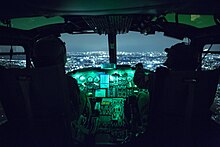
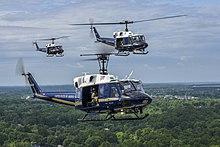
The Bell UH-1N Twin Huey is a twin-engined medium-sizedmilitary helicopterprimarily operated a utility transport. Power is provided by a PT6T-3/T400 Turbo Twin Pac, comprising a pair ofPratt & Whitney Canada PT6turboshaftengines mounted side by side and driving a sharedgearboxand single output shaft.[2][6]These engines are capable of producing up to 1,342 kW (1,800 shp). In the event of a single power section failing, the remaining section can deliver 671 kW (900 shp) for up to 30 minutes or 571 kW (765 shp) continuously, enabling the UH-1N to maintain cruise performance at maximum weight.[4][2]It is capable of flight under instrument flight rules and in nighttime conditions.[6]
The UH-1N is often flown with a four-person crew, comprising two pilots and two crew chiefs; while in the air, these crew chiefs man the weapons, while one pilot functions as a navigator and the other actively flies.[7]The interior is normally outfitted with a 15-seat configuration, in which it can be flown by a single pilot and carry up to 14 passengers; in practice, rarely could the UH-1N actually carry this many unless also carrying limited fuel and equipment due to weight limitations and weather conditions.[6]When configured to carry cargo, the cabin has an internal capacity of 220 ft³ (6.23 m³). Up to six litters can be carried in a medical evacuation arrangement.[6]An external load of up to 5,000 lb (2,268 kg) can also be carried.[1]InUnited States Marine Corps(USMC) service, up to three radios would be installed in the cabin so that commanders could remain airborne while coordinating ground troops. The UH-1N was normally armed with a single.50 caliber machine gun on the helicopter's left side, while a 7.62 millimeter machine gun is mounted on the right side.[7]
To improve safety, a high level of redundancy is present across the UH-1N's key systems; these include duplicatehydraulic,electrical, and fuel systems. Fire suppression systems were also installed.[2]The USMC opted to modify a large number of their UH-1Ns with a stability control augmentation system, which provides servo inputs to the rotor head to help stabilize the aircraft during flight. This modification removed the gyroscopic "stabilization bar" on top of the main rotor head, instead relying on the computer system for stability.[citation needed]
Operational history
[edit]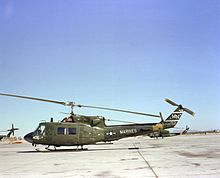
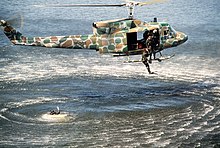

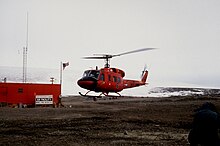
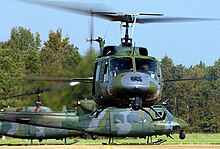

Starting in late 1970, mere months after receiving its first deliveries of the type, the USAF begun to re-equip the20th Special Operations SquadroninVietnamwith UH-1Ns, supplementing and eventually replacing the single-engined UH-1F and UH-1P.[6]Armed withminiguns(or 40 mm grenade launchers) and rocket pods, and painted camouflage with no US markings and only a Green Hornet insignia, the UH-1N supportedSpecial Forcesreconnaissance missions fromCam Ranh Bay.[8]
The first deliveries of the UH-1N to the U.S. Navy and USMC took place in 1971. In total, 205 UH-1Ns would be received, not including six VH-1N executive transports that were used to carry the US president and other high-ranking officials, operated byMarine Helicopter Squadron One.[9]Unlike in the CF, in US service, the UH-1N retained the official name "Iroquois" from the single–enginedUH-1variants, although US service personnel refer to the aircraft as a "Huey" or "Twin Huey".[10]
In Canadian service, the CH-135 Twin Huey was regularly used as a tactical transport, moving troops and equipment around the forward areas of a combat zone;medevacflights were also conducted.[3]Further activities included VIP transport, search and rescue, and drug interdiction missions. CH-135s were deployed on multiple occasions to supportUnited Nationspeacekeepingmissions in various regions, includingCentral America,Somalia,andHaiti.[3]
TheArgentine Air Forceacquired eight Bell 212s during 1978.[2]During the 1982Falklands War,Argentina deployed a pair of Bell 212s to the airstrip atGoose Greenwhere they performed general support duties, including the recovery of numerous downed pilots. By the end of the hostilities, both aircraft were still intact and flightworthy, but were captured and dismantled by the British troops.[11][2]
USMC UH-1Ns were deployed during the2003 invasion of Iraq;they were typically used to provide reconnaissance and communications support to ground troops. Multiple UH-1Ns were called upon to provide close air support during heavy fighting in theBattle of Nasiriyah.[12]In comparison with theBell AH-1 Cobraattack helicopter, the UH-1N had a wider field of fire with its weapons and thus played a useful role in close combat situations, commonly working in conjunction with Cobras.[7]
The USAF employs the aging UH-1Ns to fulfill itsICBMmission, providing a utility helicopter for transport between bases such asMinot AFB,Francis E. Warren AFBandMalmstrom AFBto missile launch sites in North Dakota, Montana, Wyoming, Nebraska, and Colorado.[6]The UH-1N is also used by the36th Rescue Squadron(36 RQS) atFairchild AFB,Washington, for conducting search-and-rescue and medical evacuation missions,[13]as well as the459th Airlift Squadronbased atYokota Air Basein Japan.[14]
In August 2013, the USAF said they were close to finalizing a plan to sustain and modernize their UH-1Ns for the next six to ten years. It was intended to address flight and safety mandates, investigate modest improvements in capabilities, and reduce capability gaps. While the UH-1N had become one of the oldest platforms operated by the service, retaining it was viewed as having "minimal risk". Fleet-wide upgrades included night vision-compatible cockpit lighting, crash-worthy seats for flight engineers, and installation of a terrain-awareness warning system and traffic collision-avoidance device. The USAF was also in the process of acquiring ex-USMC UH-1Ns, possibly involving as many as 26 helicopters to either add them to USAF's active fleet or keep them in reserve.[15]
The UH-1N saw combat service in theColombian armed conflict.On 16 October 2013, a UH-1N crashed in the northernLa Guajiradepartment in aFARC-dominated area.[16][17][18]
The USMC planned to retire the UH-1N by September 2014 after 43 years of service.Marine Light Attack Helicopter Squadron 773was the last Marine squadron operating the type, their last deployment occurring in 2013, when two helicopters sailed on aRoyal Netherlands Navyship for an African Partnership Station deployment. The UH-1N was replaced by the upgraded UH-1Y Venom; ten are remanufactured UH-1N airframes, after which the USMC decided to procure newly built airframes instead. By 2014, five unarmed HH-1Ns remained in use by the USMC until these were also replaced by UH-1Ys and retired in 2015, the only HH-1Ns remaining from 44 that were converted from 38 UH-1Ns and the six VH-1Ns.[9]The final combat deployment of USMC UH-1Ns was to Afghanistan in 2010. The service retired the UH-1N during a "sundown ceremony" atNaval Air Station Joint Reserve Base New Orleanson 28 August 2014.[19][20]
By March 2013, the USAF operated 62 UH-1N Twin Hueys, with 25 providing security atICBMsites, 19 stationed atJoint Base Andrewsto evacuate Washington-based government officials in emergencies, and 18 used for testing and training. Since most were purchased in 1969, the USAF had sought a replacement.[21]The first requirements were issued in 2007, but the process was repeatedly delayed. On 24 September 2018, the USAF declared aBoeing/Leonardosubmission of their MH-139 variant of theAgustaWestland AW139the winner, beating out theSikorsky/Lockheed MartinHH-60U Black Hawkand theSierra Nevada Corporationupgraded UH-60L Force Hawk. Boeing was awarded an initial $375 million contract for four MH-139s, with 84 helicopters planned at a total $2.38 billion program cost. Initial deliveries were planned for 2021.[22][23]
Variants
[edit]Canadian variants
[edit]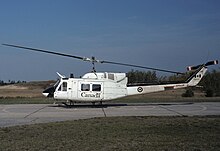
- CUH-1N Twin Huey
- Original Canadian Armed Forces designation for the UH-1N utility transport helicopter.[1][4]
- CH-135 Twin Huey
- Canadianversion of the UH-1N.[1][4]Canada purchased 50 CH-135s with deliveries starting in 1971. The aircraft were retired from the Canadian Forces starting in 1996 and struck off strength in December 1999. 41 of the surviving CH-135s were acquired by the US government in December 1999 and transferred to theNational Army of ColombiaandColombian National Police.At least one CH-135 was destroyed in combat. 135135 was transferred to the Colombian National Police and flown by the Dirección Antinarcóticos (DIRAN). It was destroyed on the ground byFARCrebels on 18 January 2002, following an incident in which it was forced down by gunfire. Two CH-135s are on display in museums, one at theCanada Aviation MuseuminOttawaand one at theNational Air Force Museum of CanadaatCFB Trenton.[24]
U.S. variants
[edit]
- UH-1N Iroquois
- Initial production model, used by the USAF, USN, and USMC. Over the years, the primary operators, the USMC has developed a number of upgrades for the aircraft including improved avionics, defenses, and aFLIRturret. The USAF planned to replace their UH-1Ns with the Common Vertical Lift Support Platform to support the service's ICBM activities,[25]but also examined a life extension for their current fleet.[26]
- VH-1N
- VIP transport configuration[1]
- HH-1N
- SAR variant.[1]
- UH-1Y Venom
- A UH-1N replacement and upgrade as part of theH-1 upgrade programfor the USMC, designed to coincide with a similar upgrade for theAH-1Wattack helicopter to AH-1Z Viper standard, with common engines and other major systems.
Italian-built variants
[edit]
- Agusta-Bell AB 212
- Civil or military utility transport version. Built under license inItalybyAgusta.
- Agusta-Bell AB 212EW
- Electronic warfare version forTurkey.
- Agusta-Bell AB 212ASW
- Anti-submarine warfare,anti-shippingversion of the AB 212 helicopter, built under license inItalybyAgusta.Operated by theItalian Navy,Hellenic NavyandIslamic Republic of Iran Navy,Peru, Spain, Turkey, and Venezuela.[4]
- The AB 212ASW is a Model 212 Twin Huey with a prominent radome above the cockpit. Early production had a dome-shaped radome, while later production had a flatter "drum" radome. A left side winch is used for dipping the BendixASQ-18sonar. Other changes include structural reinforcement for a gross weight of 11,197 lbs (5080 kg),ECM,shipboard deck tie-down attachments and corrosion protection. Armament is two Mk 44 or Mk 46 torpedoes or two depth charges in the ASW role and four AS.12 air-to-surface wire-guided missiles for the anti-shipping role.[27][28]
Operators
[edit]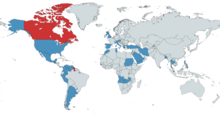


- Argentine Air Force[29]
- 7th Air Brigade - 1st Search and Rescue Squadron
- Bangladesh Air Force[29]
- 9th Squadron "Scorpions"[30]

- Italian Air Forceoperates 36 aircraft[29][31]
- Italian Navy[29]
- Lebanese Air Force7 aircraft[citation needed]
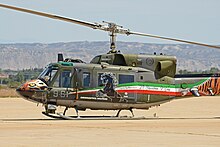
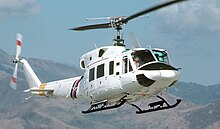
- Philippine Air Force- 4 Units delivered to 250th Presidential Airlift Wing,251 Special Airlift Squadron. Retired.[29][32]
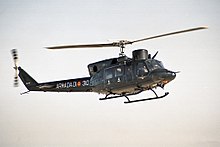

Former operators
[edit]
- Canadian Forces[35]
- 403 Helicopter Operational Training Squadron[36]
- 408 Tactical Helicopter Squadron[37]
- 422 Tactical Helicopter Squadron[36]
- 424 Transport & Rescue Squadron[38]
- 427 Tactical Helicopter Squadron[39]
- 430 Tactical Helicopter Squadron[40]
- 444 Combat Support Squadron[41]
- VU 32 - pre-UnificationRoyal Canadian NavyUtility Squadron[42]
- Aerospace Engineering Test Establishment[43]
- Base Flight Cold Lake[44]
- Base Rescue Goose Bay[41]


Aircraft on display
[edit]- Battleship Memorial Park,Mobile, Alabama, U.S.[51]
- CH-135 135114 -Canada Aviation and Space Museum,Ottawa,Ontario,Canada[52]
- CH-135 135102 -National Air Force Museum of Canada[53]
- UH-1N 159198 –Flying Leatherneck Aviation Museumat MCAS Miramar,San Diego, California.[54]
Specifications (USMC UH-1N, as modified)
[edit]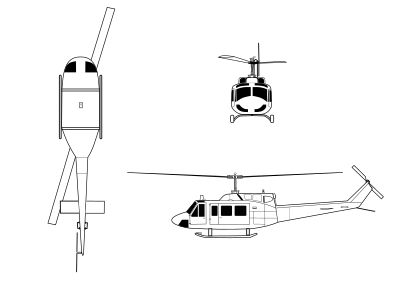
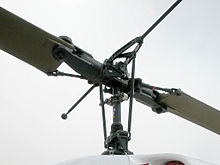
Data fromUSMC UH-1N Fact Sheet,[55]The International Directory of Military Aircraft, 2002-2003[56]
General characteristics
- Crew:4 (pilot, co-pilot, crew chief, gunner)
- Capacity:6-8 combat-equipped troops, or 4,400 lb (1,996 kg) equivalent cargo
- Length:57 ft 8 in (17.58 m)
- Height:14 ft 5 in (4.39 m)
- Max takeoff weight:10,500 lb (4,763 kg)
- Powerplant:1 ×Pratt & Whitney Canada T400-CP-400coupledturboshaftengine, 1,250 shp (930 kW)
- 900 shp (671 kW) emergency rating for each power section
- Main rotor diameter:48 ft 0 in (14.63 m)
- Main rotor area:1,808 sq ft (168.0 m2)
- Blade section:-root:NACA 0010.8;tip:NACA 0005.4 mod[57]
Performance
- Maximum speed:130 kn (150 mph, 240 km/h)
- Cruise speed:110 kn (130 mph, 200 km/h)
- Range:248 nmi (285 mi, 459 km)
- Service ceiling:17,300 ft (5,300 m)
- Rate of climb:1,755 ft/min (8.92 m/s)
Armament
- 2.75-inch (70 mm) rocket pods,
- 0.50 in (12.7 mm)GAU-16machine gun,
- 7.62 mm (0.308 in)GAU-17minigun or 7.62 mm (0.308 in)M240lightweight machine gun
Gallery
[edit]-
CH-135 Twin Huey 135102 serving with theMultinational Force and ObserversSinai, Egypt, 1989.
-
CH-135 Twin Huey 135137 in the original blue-gray and green camouflage pattern worn by these aircraft prior to 1986/88.
-
CH-135 Twin Huey 135135 in the early-style SAR markings, 1988. This aircraft was serving withBase Rescue Goose Bayand had formerly been assigned to 424 Transport & Rescue Squadron,CFB Trenton.
-
CH-135 Twin Huey 135127 fromBase Rescue Goose Bayin the later SAR scheme used after 1986–88.
-
CH-135 Twin Huey 135103 in special flight test markings. The aircraft was used by the Aerospace Engineering Test Establishment atCFB Cold Lake,1987.
-
CH-135 Twin Huey 135103 after repainting in anti-IR olive and green scheme
-
Canadian CH-135 Twin Hueys serving with theMultinational Force and ObserversSinai, Egypt 1989
-
CH-135 Twin Huey badge worn by someCanadian Forcesair and ground crew, 1980s
-
408 Tactical Helicopter SquadronUTTH Flight badge worn by CH-135 Twin Huey crews circa 1990. The badge is based on the shield of the province ofAlberta.
-
UH-1N serving with the1st Helicopter Squadronat Joint Base Andrews.
See also
[edit]Related development
Related lists
References
[edit]Citations
[edit]- ^abcdefgMutza 1986, pp. 31-33.
- ^abcdefghijk"El Bell 212 en la Fuerza Aérea".FAA official magazine.Archived fromthe originalon 28 October 2008.Retrieved30 January2010.
- ^abcAir Force Public Affairs / Department of National Defence (6 April 2004)."Bell CH-135 Twin Huey".Archived fromthe originalon 24 September 2012.Retrieved10 January2013.
- ^abcdefgDrendel 1983, pp. 14-17.
- ^Eden 2004, p. 47.
- ^abcdef"UH-1N Huey".af.mil.Retrieved26 June2022.
- ^abcHamel, James D. (18 November 2005)."Corps' oldest helo proves worth in Iraq".marines.mil.
- ^MutzaAir EnthusiastDecember 1986–April 1987, pp. 30–31.
- ^ab"Marine Corps to Retire UH-1N Helicopters in September; HH-1Ns in 2015".Seapowermagazine.org.4 August 2014. Archived fromthe originalon 11 August 2014.Retrieved2 August2021.
- ^Drendel 1983, p. 9.
- ^"H-83 Bell 212 C/N 30834".Helis.com.Archivedfrom the original on 18 October 2012.Retrieved10 January2013.
- ^Stout, Jay A.Hammer from Above, Marine Air Combat Over Iraq.Ballantine Books, 2005.ISBN978-0-89141-871-9.
- ^Bailey, Carl E. (2 August 2017)."Factsheet 36 Rescue Squadron (AETC)".Air Force Historical Research Agency.Retrieved17 February2018.
- ^"Yokota deems UH-1N copters 'completely safe'".Stars and Stripes.3 December 2004. Archived fromthe originalon 7 November 2016.Retrieved6 November2016.
- ^"Air Force planning decade-long Huey extension".Militarytimes.com. 22 August 2013. Archived fromthe originalon 22 August 2013.Retrieved23 August2013.
- ^"Se accidentó helicóptero en la frontera con Venezuela".El Colombiano.Archivedfrom the original on 20 October 2013.Retrieved20 October2013.
- ^"Doce soldados muertos deja ataque de las FARC en Maicao | Nación".Noticiascaracol.com.Archivedfrom the original on 25 October 2013.Retrieved20 October2013.
- ^"Tres policías muertos en atentado de las Farc en Maicao | 20130201".Caracol.com.co.Archivedfrom the original on 20 October 2013.Retrieved20 October2013.
- ^"Final Flight of UH-1N Huey for HMLA-773".marines.mil. 3 September 2014. Archived fromthe originalon 7 September 2014.Retrieved7 September2014.
- ^Jennings, Gareth (4 September 2014)."UH-1N 'Huey' retired from USMC service".IHS Jane's Defence Weekly.Archivedfrom the original on 6 December 2014.
- ^"UH-72 Lakota Could Be a Candidate for Air Force Duty".Defensemedianetwork.com. 10 March 2013. Archived fromthe originalon 14 May 2013.Retrieved17 May2013.
- ^"Boeing wins UH-1N replacement contract from USAF".Flight International. 25 September 2018. Archived fromthe originalon 25 September 2018.Retrieved27 September2018.
- ^"Boeing Wins Air Force Contract to Build Huey Replacement".Air Force Magazine.24 September 2018. Archived fromthe originalon 27 September 2018.Retrieved27 September2018.
- ^Walker, RWR (June 2006)."Canadian Military Aircraft Serial Numbers Canadian Armed Forces CH-135 Twin Huey detailed list".Archived fromthe originalon 31 October 2007.Retrieved2 December2008.
- ^"USAF 2011 Budget justification"(PDF).saffm.hq.af.mil. p. 4-1. Archived fromthe original(PDF)on 4 March 2012.Retrieved15 July2010.
- ^"USAF Planning Decade-Long Huey Extension".Archived fromthe originalon 22 August 2013.
- ^Green 1980, p. 229.
- ^Wood 1985, p. 490.
- ^abcdefghijklmnopqrstuvwxyzaaabacadaeafag"World Air Forces 2018".Flightglobal Insight. 2018.Archivedfrom the original on 6 February 2018.Retrieved16 June2018.[dead link]
- ^"Flying high in Bangladesh".Air International.Archivedfrom the original on 4 October 2021.
- ^"HH.212".Aeronautica Militare.Archivedfrom the original on 27 February 2019.Retrieved22 May2019.
- ^https://www.scramble.nl/planning/orbats/philippines/philippine-air-force-history
- ^"World Air Forces 2021".FlightGlobal. 4 December 2020.Retrieved5 January2021.
- ^"World Air Forces 2014"(PDF).Flightglobal Insight. 2014.Archived(PDF)from the original on 25 December 2013.Retrieved17 January2014.
- ^"Bell CH-135 TWIN HUEY".canadianwings.com.Archived fromthe originalon 1 February 2014.Retrieved21 January2014.
- ^ab"403 Squadron Activated as Operational Training Squadron".Air Force Public Affairs / Department of National Defence.24 March 2010. Archived fromthe originalon 20 April 2013.Retrieved10 January2013.
- ^"408 Tactical Helicopter Squadron (THS) History".Air Force Public Affairs / Department of National Defence.22 September 2011. Archived fromthe originalon 20 April 2013.Retrieved10 January2013.
- ^"424 Squadron History".Air Force Public Affairs / Department of National Defence.31 August 2010. Archived fromthe originalon 13 November 2012.Retrieved10 January2013.
- ^"History of 427 Special Operations Aviation Squadron".Air Force Public Affairs / Department of National Defence.28 November 2008. Archived fromthe originalon 2 September 2012.Retrieved10 January2012.
- ^"430 Squadron".Air Force Public Affairs / Department of National Defence.28 November 2008. Archived fromthe originalon 22 May 2013.Retrieved10 January2012.
- ^ab"444 Squadron History".Air Force Public Affairs / Department of National Defence.11 April 2012. Archived fromthe originalon 29 September 2012.Retrieved10 January2012.
- ^"Utility Squadron VU 32".AEROWAREdesigns.2012. Archived fromthe originalon 6 August 2012.Retrieved10 January2013.
- ^Shaw 1990, p. 86.
- ^"417 Combat Support Squadron - History".Air Force Public Affairs / Department of National Defence.3 April 2012. Archived fromthe originalon 13 November 2012.Retrieved10 January2013.
- ^"Israel Air Force - Aircraft Types".aeroflight.com.Archivedfrom the original on 3 March 2010.Retrieved22 January2013.
- ^"Jamaica Defence Force Aircraft".jdfmil.org. Archived fromthe originalon 11 May 2013.Retrieved26 January2013.
- ^"30 Years of Helicopter Operations".mindef.gov.sg. Archived fromthe originalon 29 July 2013.Retrieved22 January2013.
- ^"Final Flight of UH-1N Huey for HMLA-773".helihub.com.Archivedfrom the original on 7 September 2014.Retrieved3 September2014.
- ^AirForces Monthlyp. 14 January 2014
- ^""Huey" Helicopters Fly Final Flights for the U.S. Navy ".ktvn.com. 6 April 2009.Archivedfrom the original on 25 September 2015.
- ^"Aircraft collection".ussalabama.com. Archived fromthe originalon 4 September 2012.Retrieved25 June2022.
- ^Canada Aviation and Space Museum,ed. (2018)."Bell CH-135" Twin Huey "".Archived fromthe originalon 26 February 2021.Retrieved9 August2018.
- ^"Twin Huey".National Air Force Museum of Canada.Retrieved7 March2020.
- ^Flying Leatherneck Aviation Museum(2022)."Bell UH-1N".flyingleathernecks.org.Archivedfrom the original on 12 April 2022.Retrieved25 June2022.
- ^"USMC UH-1N fact sheet".United States Marine Corps. 4 September 2008. Archived fromthe originalon 16 June 2007.Retrieved14 October2012.
- ^Frawley 2002, p. 33.
- ^Lednicer, David."The Incomplete Guide to Airfoil Usage".m-selig.ae.illinois.edu.Retrieved16 April2019.
Bibliography
[edit]- Chant, Christopher.Fighting Helicopters of the 20th Century.Graham Beehag Books, Christchurch, Dorset, England, 1996.
- Debay, Yves.Combat Helicopters.France: Histoire & Collections, 1996.
- Drendel, Lou.Huey.Squadron/Signal Publications, Carrollton, Texas, 1983.ISBN0-89747-145-8.
- Eden, Paul. "Bell 212/412".Encyclopedia of Modern Military Aircraft.London: Amber Books, 2004.ISBN1-904687-84-9.
- Francillon, Rene, J.Vietnam: The War in the Air,New York: Arch Cape Press, 1987.
- Frawley, Gerard.The International Directory of Military Aircraft,Aerospace Publications Pty Ltd, 2002.ISBN1-875671-55-2.
- Green, William.Observers Aircraft,Frederick Warne Publishing, 1980.ISBN0-7232-1604-5.
- Hoyle, Craig. "World Air Forces Directory".Flight International,Vol. 182, No. 5370. pp. 40–64. ISSN 0015-3710.
- Mesko, Jim,Airmobile: The Helicopter War in Vietnam.Squadron Signal Publications, 1984.
- Mutza, Wayne. "Covertly to Cambodia".Air Enthusiast,Thirty-two, December 1986–April 1987. pp. 22–31. ISSN 0143-5450.
- Mutza, Wayne.UH-1 Huey in action.Carrollton, TX: Squadron/Signal Publications, 1986.ISBN0-89747-179-2.
- Mutza, Wayne.UH-1 Huey in Colors.Carrollton, TX: Squadron/Signal Publications, 1992.ISBN0-89747-279-9.
- Shaw, Robbie:Superbase 18 Cold Lake- Canada's Northern Guardians,Osprey Publishing, London, 1990.ISBN0-85045-910-9
- Specifications for 204, 205 and 214 Huey Plus
- Wood, Derek.Jane's World Aircraft Recognition Handbook,Jane's Publishing Company 1985.ISBN0-7106-0343-6.










